[English] 日本語
 Yorodumi
Yorodumi- PDB-6cpm: Structure of the USP15 deubiquitinase domain in complex with a th... -
+ Open data
Open data
- Basic information
Basic information
| Entry | Database: PDB / ID: 6cpm | ||||||
|---|---|---|---|---|---|---|---|
| Title | Structure of the USP15 deubiquitinase domain in complex with a third-generation inhibitory Ubv | ||||||
 Components Components |
| ||||||
 Keywords Keywords | SIGNALING PROTEIN / deubiuqitination / Ubv / high-affinity / inhibition | ||||||
| Function / homology |  Function and homology information Function and homology informationnegative regulation of antifungal innate immune response / regulation of intrinsic apoptotic signaling pathway in response to osmotic stress by p53 class mediator / protein K27-linked deubiquitination / positive regulation of RIG-I signaling pathway / regulation of RNA metabolic process / monoubiquitinated protein deubiquitination / ubiquitin-modified histone reader activity / transforming growth factor beta receptor binding / deubiquitinase activity / K48-linked deubiquitinase activity ...negative regulation of antifungal innate immune response / regulation of intrinsic apoptotic signaling pathway in response to osmotic stress by p53 class mediator / protein K27-linked deubiquitination / positive regulation of RIG-I signaling pathway / regulation of RNA metabolic process / monoubiquitinated protein deubiquitination / ubiquitin-modified histone reader activity / transforming growth factor beta receptor binding / deubiquitinase activity / K48-linked deubiquitinase activity / transcription elongation-coupled chromatin remodeling / SMAD binding / protein deubiquitination / BMP signaling pathway / transforming growth factor beta receptor signaling pathway / Downregulation of TGF-beta receptor signaling / negative regulation of transforming growth factor beta receptor signaling pathway / UCH proteinases / ubiquitinyl hydrolase 1 / cysteine-type deubiquitinase activity / Ub-specific processing proteases / nuclear body / cysteine-type endopeptidase activity / mitochondrion / proteolysis / nucleoplasm / identical protein binding / nucleus / cytosol / cytoplasm Similarity search - Function | ||||||
| Biological species |  Homo sapiens (human) Homo sapiens (human) | ||||||
| Method |  X-RAY DIFFRACTION / X-RAY DIFFRACTION /  MOLECULAR REPLACEMENT / Resolution: 2.011 Å MOLECULAR REPLACEMENT / Resolution: 2.011 Å | ||||||
 Authors Authors | Singer, A.U. / Teyra, J. / Boehmelt, G. / Lenter, M. / Sicheri, F. / Sidhu, S.S. | ||||||
 Citation Citation |  Journal: Structure / Year: 2019 Journal: Structure / Year: 2019Title: Structural and Functional Characterization of Ubiquitin Variant Inhibitors of USP15. Authors: Teyra, J. / Singer, A.U. / Schmitges, F.W. / Jaynes, P. / Kit Leng Lui, S. / Polyak, M.J. / Fodil, N. / Krieger, J.R. / Tong, J. / Schwerdtfeger, C. / Brasher, B.B. / Ceccarelli, D.F.J. / ...Authors: Teyra, J. / Singer, A.U. / Schmitges, F.W. / Jaynes, P. / Kit Leng Lui, S. / Polyak, M.J. / Fodil, N. / Krieger, J.R. / Tong, J. / Schwerdtfeger, C. / Brasher, B.B. / Ceccarelli, D.F.J. / Moffat, J. / Sicheri, F. / Moran, M.F. / Gros, P. / Eichhorn, P.J.A. / Lenter, M. / Boehmelt, G. / Sidhu, S.S. | ||||||
| History |
|
- Structure visualization
Structure visualization
| Structure viewer | Molecule:  Molmil Molmil Jmol/JSmol Jmol/JSmol |
|---|
- Downloads & links
Downloads & links
- Download
Download
| PDBx/mmCIF format |  6cpm.cif.gz 6cpm.cif.gz | 195.6 KB | Display |  PDBx/mmCIF format PDBx/mmCIF format |
|---|---|---|---|---|
| PDB format |  pdb6cpm.ent.gz pdb6cpm.ent.gz | 151.9 KB | Display |  PDB format PDB format |
| PDBx/mmJSON format |  6cpm.json.gz 6cpm.json.gz | Tree view |  PDBx/mmJSON format PDBx/mmJSON format | |
| Others |  Other downloads Other downloads |
-Validation report
| Summary document |  6cpm_validation.pdf.gz 6cpm_validation.pdf.gz | 471.7 KB | Display |  wwPDB validaton report wwPDB validaton report |
|---|---|---|---|---|
| Full document |  6cpm_full_validation.pdf.gz 6cpm_full_validation.pdf.gz | 476.6 KB | Display | |
| Data in XML |  6cpm_validation.xml.gz 6cpm_validation.xml.gz | 36.4 KB | Display | |
| Data in CIF |  6cpm_validation.cif.gz 6cpm_validation.cif.gz | 52.7 KB | Display | |
| Arichive directory |  https://data.pdbj.org/pub/pdb/validation_reports/cp/6cpm https://data.pdbj.org/pub/pdb/validation_reports/cp/6cpm ftp://data.pdbj.org/pub/pdb/validation_reports/cp/6cpm ftp://data.pdbj.org/pub/pdb/validation_reports/cp/6cpm | HTTPS FTP |
-Related structure data
| Related structure data |  6crnC  6dj9C  6ml1C  6csi C: citing same article ( |
|---|---|
| Similar structure data |
- Links
Links
- Assembly
Assembly
| Deposited unit | 
| ||||||||
|---|---|---|---|---|---|---|---|---|---|
| 1 | 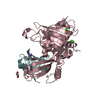
| ||||||||
| 2 | 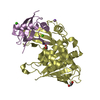
| ||||||||
| Unit cell |
|
- Components
Components
-Protein , 2 types, 4 molecules CDEF
| #1: Protein | Mass: 39753.023 Da / Num. of mol.: 2 Source method: isolated from a genetically manipulated source Source: (gene. exp.)  Homo sapiens (human) / Gene: USP15, KIAA0529 / Production host: Homo sapiens (human) / Gene: USP15, KIAA0529 / Production host:  #2: Protein | Mass: 9639.934 Da / Num. of mol.: 2 Source method: isolated from a genetically manipulated source Details: This is a Ubv (ubiquitin variant) selected by phage display to bind the USP15 USP domain with high affinity Source: (gene. exp.)  Homo sapiens (human) / Production host: Homo sapiens (human) / Production host:  |
|---|
-Non-polymers , 6 types, 545 molecules 



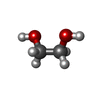






| #3: Chemical | ChemComp-CA / #4: Chemical | #5: Chemical | #6: Chemical | #7: Chemical | ChemComp-EDO / | #8: Water | ChemComp-HOH / | |
|---|
-Experimental details
-Experiment
| Experiment | Method:  X-RAY DIFFRACTION / Number of used crystals: 1 X-RAY DIFFRACTION / Number of used crystals: 1 |
|---|
- Sample preparation
Sample preparation
| Crystal | Density Matthews: 2.41 Å3/Da / Density % sol: 48.89 % |
|---|---|
| Crystal grow | Temperature: 295 K / Method: vapor diffusion, sitting drop Details: 16% PEG3350, 100 mM MES, 200 mM CaCl2, cryoprotected with the identical buffer plus 25% glycerol |
-Data collection
| Diffraction | Mean temperature: 100 K |
|---|---|
| Diffraction source | Source:  ROTATING ANODE / Type: RIGAKU MICROMAX-007 / Wavelength: 1.54178 Å ROTATING ANODE / Type: RIGAKU MICROMAX-007 / Wavelength: 1.54178 Å |
| Detector | Type: RIGAKU RAXIS IV++ / Detector: IMAGE PLATE / Date: Jun 22, 2017 / Details: MIRRORS |
| Radiation | Protocol: SINGLE WAVELENGTH / Monochromatic (M) / Laue (L): M / Scattering type: x-ray |
| Radiation wavelength | Wavelength: 1.54178 Å / Relative weight: 1 |
| Reflection | Resolution: 2.01→50 Å / Num. obs: 60994 / % possible obs: 99.9 % / Redundancy: 3.7 % / Rmerge(I) obs: 0.067 / Net I/σ(I): 23.4 |
| Reflection shell | Resolution: 2.01→2.08 Å / Redundancy: 3.5 % / Rmerge(I) obs: 0.507 / Mean I/σ(I) obs: 2.96 / Num. unique obs: 6036 / CC1/2: 0.767 / % possible all: 99.5 |
- Processing
Processing
| Software |
| |||||||||||||||||||||||||||||||||||||||||||||||||||||||||||||||||||||||||||||||||||||||||||||||||||||||||
|---|---|---|---|---|---|---|---|---|---|---|---|---|---|---|---|---|---|---|---|---|---|---|---|---|---|---|---|---|---|---|---|---|---|---|---|---|---|---|---|---|---|---|---|---|---|---|---|---|---|---|---|---|---|---|---|---|---|---|---|---|---|---|---|---|---|---|---|---|---|---|---|---|---|---|---|---|---|---|---|---|---|---|---|---|---|---|---|---|---|---|---|---|---|---|---|---|---|---|---|---|---|---|---|---|---|---|
| Refinement | Method to determine structure:  MOLECULAR REPLACEMENT MOLECULAR REPLACEMENTStarting model: usp15 and Ubv model for the USP15/AM5 structure Resolution: 2.011→38.205 Å / SU ML: 0.19 / Cross valid method: FREE R-VALUE / σ(F): 1.35 / Phase error: 21.36 / Stereochemistry target values: ML
| |||||||||||||||||||||||||||||||||||||||||||||||||||||||||||||||||||||||||||||||||||||||||||||||||||||||||
| Solvent computation | Shrinkage radii: 0.9 Å / VDW probe radii: 1.11 Å / Solvent model: FLAT BULK SOLVENT MODEL | |||||||||||||||||||||||||||||||||||||||||||||||||||||||||||||||||||||||||||||||||||||||||||||||||||||||||
| Refinement step | Cycle: LAST / Resolution: 2.011→38.205 Å
| |||||||||||||||||||||||||||||||||||||||||||||||||||||||||||||||||||||||||||||||||||||||||||||||||||||||||
| Refine LS restraints |
| |||||||||||||||||||||||||||||||||||||||||||||||||||||||||||||||||||||||||||||||||||||||||||||||||||||||||
| LS refinement shell |
|
 Movie
Movie Controller
Controller


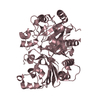

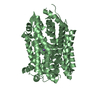

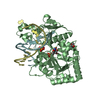
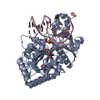
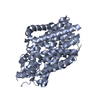
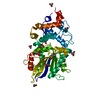
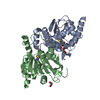
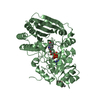
 PDBj
PDBj








